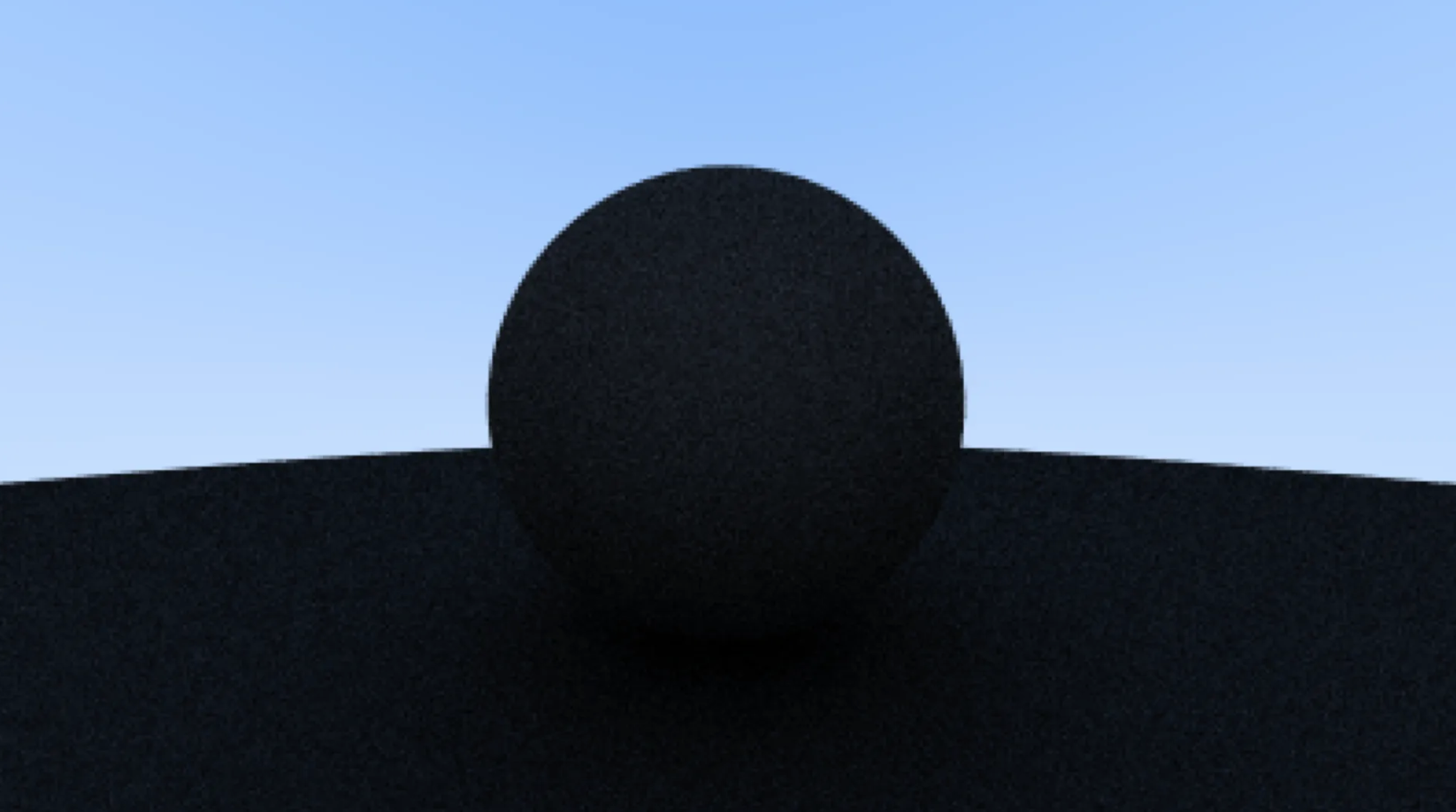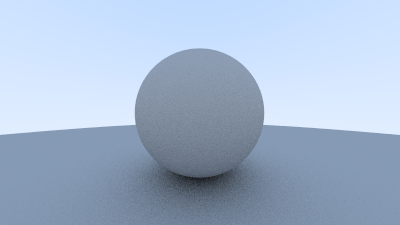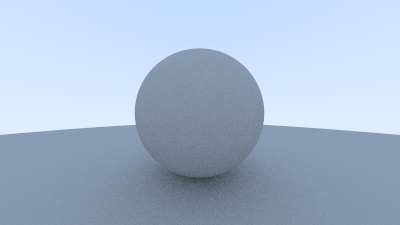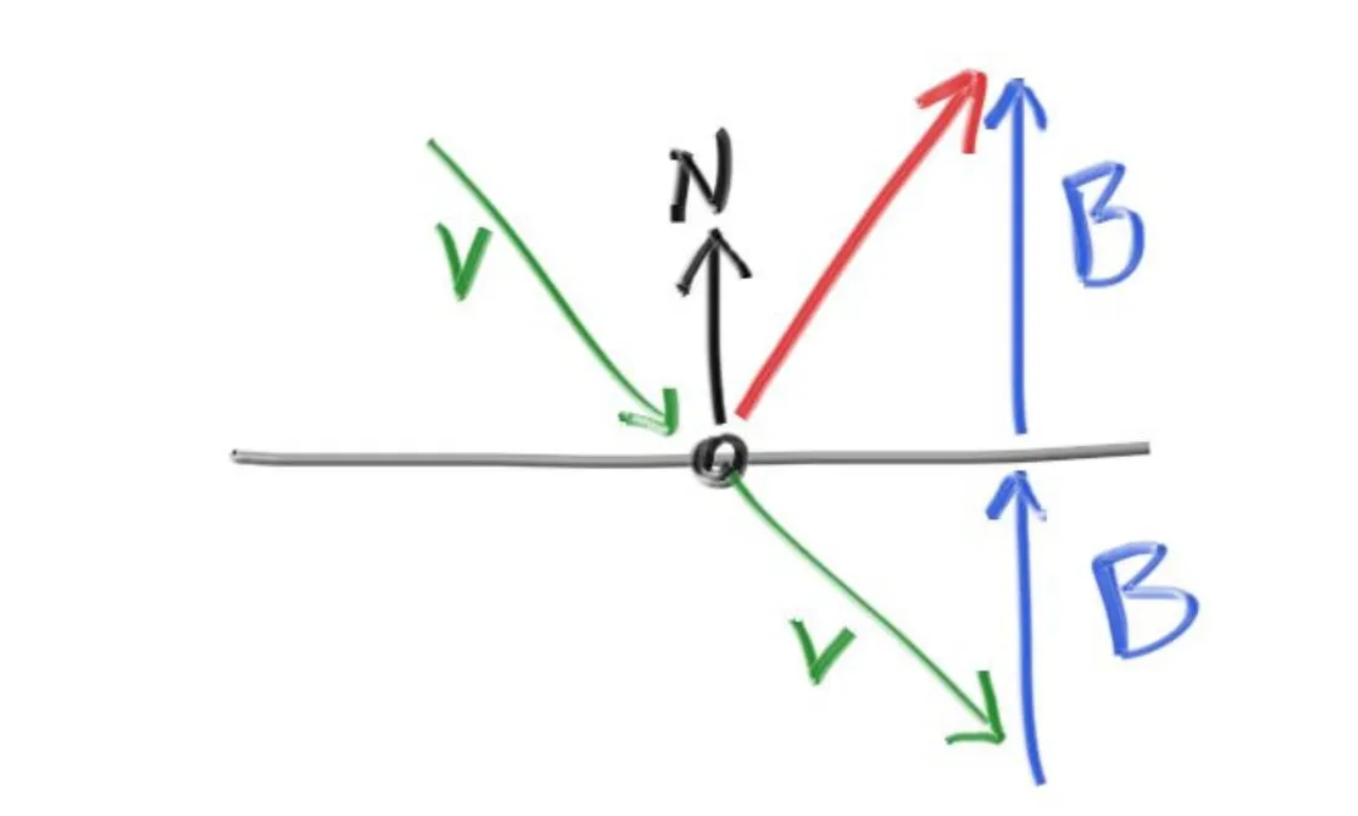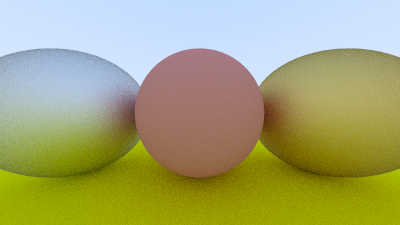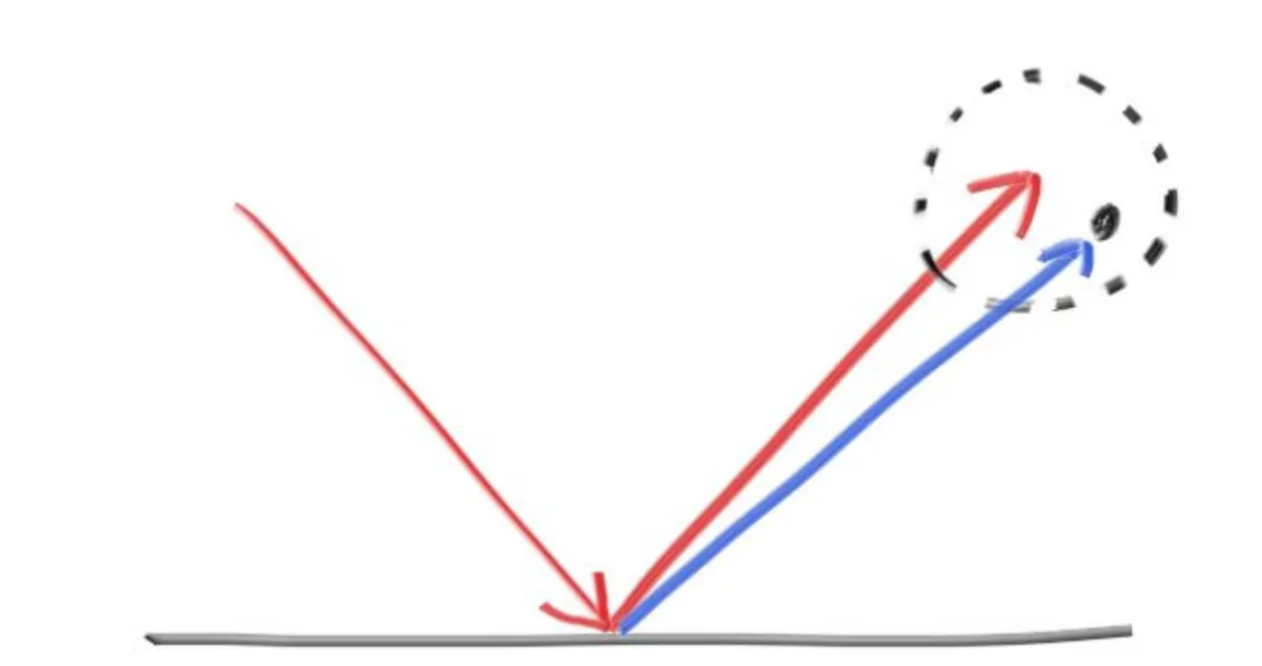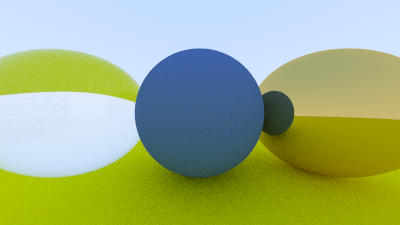慢散射材质
简单的慢散射模型
慢散射物体不会发射光,他们的颜色由自己本身的性质,以及光线散射附近物体的性质所决定。如果一条光线射向两个慢散射物体,那么这个光线会发生一些随机的反射。
慢散射模型
以光线与物体的接触点为切点,以该接触点的单位法向量 作为半径,有一个接触点切球,在这个切球内随机取一点作为反射光线的方向。
从上图可得反射光线可以通过下面的方式计算
\[
\textbf{r}' = \textbf{r} + \textbf{p} + \textbf{N} + \textbf{s}
\]
下面实现一些随机函数来随机一个单位球内的向量。最简单的方法是在立方体内随机一点,然后看这点距离原点的半径是否大于单位球,如果满足就返回,否则就继续随机。
class Vec3 { inline static Vec3 random (double min, double max) return Vec3 (randomDouble (min, max), randomDouble (min, max), randomDouble (min, max)); } }; Vec3 randomInUnitSphere () { while (true ) { auto p = Vec3::random (-1 , 1 ); if (p.lengthSquared () >= 1 ) continue ; return p; } }
然后在 rayColor
里使用上面的公式计算反射光线,然后再递归计算反射光线的颜色。注意到由于是递归,所以要考虑最大深度,如果超过了最大反射深度,就返回黑色(也就是没有光照)。
Color rayColor (const Ray& r, const Hittable& world, int depth) { if (depth <= 0 ) return Color (0 , 0 , 0 ); HitRecord rec; if (world.hit (r, 0 , INFTY, rec)) { Point3 target = rec.p + rec.normal + randomInUnitSphere (); return 0.5 * rayColor (Ray (rec.p, target - rec.p), world, depth - 1 ); } Vec3 unitDirection = unitVector (r.direction ()); auto t = 0.5 * (unitDirection.y () + 1.0 ); return (1.0 -t) * Color (1.0 , 1.0 , 1.0 ) + t*Color (0.5 , 0.7 , 1.0 ); }
由此得到下面的结果。
Gamma 校正
可以看到上面的结果非常暗,这是因为每次反射能量都被削弱了 50%。
Color rayColor (const Ray& r, const Hittable& world, int depth) { if (depth <= 0 ) return Color (0 , 0 , 0 ); HitRecord rec; if (world.hit (r, 0 , INFTY, rec)) { Point3 target = rec.p + rec.normal + randomInUnitSphere (); return 0.5 * rayColor (Ray (rec.p, target - rec.p), world, depth - 1 ); } Vec3 unitDirection = unitVector (r.direction ()); auto t = 0.5 * (unitDirection.y () + 1.0 ); return (1.0 -t) * Color (1.0 , 1.0 , 1.0 ) + t*Color (0.5 , 0.7 , 1.0 ); }
所以对于这张图片的所有颜色来说,大部分都集中在更接近 0
的区域,而一张经过 Gamma
校正的图来说,这些颜色应该遵循一定的分布,比如较为均匀地分布在 0 到 1
之间。在这个例子里,我们先采用一种简单的校正方式,也就是令 Gamma =
2。
void writeColor (std::ostream &out, Color pixelColor, int samplesPerPixel) auto r = pixelColor.x (); auto g = pixelColor.y (); auto b = pixelColor.z (); auto scale = 1.0 / samplesPerPixel; r = sqrt (scale * r); g = sqrt (scale * g); b = sqrt (scale * b); out << static_cast <int >(256 * clamp (r, 0.0 , 0.999 )) << ' ' << static_cast <int >(256 * clamp (g, 0.0 , 0.999 )) << ' ' << static_cast <int >(256 * clamp (b, 0.0 , 0.999 )) << '\n' ; }
忽略非常接近 0 的反射,得到下面的结果。
Color rayColor (const Ray& r, const Hittable& world, int depth) { if (depth <= 0 ) return Color (0 , 0 , 0 ); HitRecord rec; if (world.hit (r, 0.001 , INFTY, rec)) { Point3 target = rec.p + rec.normal + randomInUnitSphere (); return 0.5 * rayColor (Ray (rec.p, target - rec.p), world, depth - 1 ); } Vec3 unitDirection = unitVector (r.direction ()); auto t = 0.5 * (unitDirection.y () + 1.0 ); return (1.0 -t) * Color (1.0 , 1.0 , 1.0 ) + t*Color (0.5 , 0.7 , 1.0 ); }
Lambertian 反射
在 Lambert
模型里,与上面基础模型唯一的区别是,它使用随机单位向量 。
Vec3 randomUnitVector () { return unitVector (randomInUnitSphere ()); }
得到的是一个看着差不多的结果。
但可以留意到的是,影子比上面少了。这个可以理解为,因为光线的反射更为“均匀”了,这使得有更多的光线进入相机,从而使得整个画面更为光亮。
金属材质
材质的抽象类
材质需要做两件事情:
产生一条反射光线(如果有)
如果反射了,表明光的强度需要衰减多少
class Material {public : virtual bool scatter ( const Ray& rIn, const HitRecord& rec, Color& attenuation, Ray& scattered ) const 0 ;};
由于光线碰到物体之后发生反射(或者被吸收)这个行为是由材质决定的,所以在击中记录
hitRecord 里应该有材质的信息。
struct HitRecord { Point3 p; Vec3 normal; double t; shared_ptr<Material> material; bool frontFace; inline void setFaceNormal (const Ray& r, const Vec3& outwardNormal) frontFace = dot (r.direction (), outwardNormal) < 0 ; normal = frontFace ? outwardNormal : -outwardNormal; } };
物体需要有材质信息,这个材质信息会在被光线击中的时候,存放在击中记录里面。
class Sphere : public Hittable {public : Point3 center; double radius; shared_ptr<Material> material; public : Sphere () {} Sphere (Point3 c, double r): center (c), radius (r) {}; virtual bool hit (const Ray& r, double tMin, double tMax, HitRecord& rec) const override void setMaterial (shared_ptr<Material> m) material = m; } };
Lambertian 材质
之前的慢散射模型可以抽象到 Lambertian
材质里去,接受入射光线,通过法向量与随机向量产成反射光线,颜色衰减等,都能实现在材质的
scatter 函数里。
class Lambertian : public Material {public : Color albedo; public : Lambertian (const Color& a): albedo (a) {} virtual bool scatter ( const Ray& rIn, const HitRecord& rec, Color& attenuation, Ray& scattered ) const override auto scatterDirection = rec.normal + randomUnitVector (); if (scatterDirection.nearZero ()) { scatterDirection = rec.normal; } scattered = Ray (rec.p, scatterDirection); attenuation = albedo; return true ; } };
需要注意的是,如果 randomUnitVector 刚好和
normal
相反,则两者之和有可能产生一个零向量,导致一些未知问题,所以为了避免这个问题,加入
nearZero 检测,对于这种情况就直接使用
normal。
金属材质与镜面反射
对于大多数金属来说,对入射光会进行镜面反射。
从示意图中可以看到,反射光为 \(\textbf{v} +
2\textbf{b}\) ,其中法向量 \(\textbf{n}\) 为单位向量,\(\textbf{b}\) 的长度是 \(\textbf{v}\) 在法向量方向上的投影,但因为
\(\textbf{v}\) 与 \(\textbf{n}\)
反向,所以需要先反向再求点积。最后有
\[
\begin{align*}
\textbf{r} &= \textbf{v} + 2\textbf{b} \\
&= \textbf{v} + 2(-\textbf{v} \cdot \textbf{n})\textbf{n} \\
&= \textbf{v} - 2 (\textbf{v} \cdot \textbf{n}) \textbf{n}
\end{align*}
\]
将这个反射逻辑放入金属材质里得到下面的 Metal 类。
class Metal : public Material {public : Color albedo; public : Metal (const Color& a): albedo (a) {} virtual bool scatter ( const Ray& rIn, const HitRecord& rec, Color& attenuation, Ray& scattered ) const override Vec3 reflected = reflect (unitVector (rIn.direction ()), rec.normal); scattered = Ray (rec.p, reflected); attenuation = albedo; return (dot (scattered.direction (), rec.normal) > 0 ); } };
三个球的场景
下面的场景有三个球,中间的是 Lambertian
材质,其余两个是金属材质。注意修改 rayColor
的颜色计算代码,因为目前反射光以及颜色都由材质决定了。
#include <iostream> #include "constants.h" #include "color.h" #include "hittable_list.h" #include "sphere.h" #include "camera.h" #include "material.h" Color rayColor (const Ray& r, const Hittable& world, int depth) { if (depth <= 0 ) return Color (0 , 0 , 0 ); HitRecord rec; if (world.hit (r, 0.001 , INFTY, rec)) { Ray scattered; Color attenuation; if (rec.material->scatter (r, rec, attenuation, scattered)) { return attenuation * rayColor (scattered, world, depth - 1 ); } return Color (0 , 0 , 0 ); } Vec3 unitDirection = unitVector (r.direction ()); auto t = 0.5 * (unitDirection.y () + 1.0 ); return (1.0 -t) * Color (1.0 , 1.0 , 1.0 ) + t*Color (0.5 , 0.7 , 1.0 ); } int main () const auto aspectRatio = 16.0 /9.0 ; const int imageWidth = 400 ; const int imageHeight = static_cast <int >(imageWidth / aspectRatio); const int samplesPerPixel = 100 ; const int maxDepth = 50 ; HittableList world; auto materialGround = make_shared <Lambertian>(Color (0.8 , 0.8 , 0.0 )); auto materialCenter = make_shared <Lambertian>(Color (0.7 , 0.3 , 0.3 )); auto materialLeft = make_shared <Metal>(Color (0.8 , 0.8 , 0.8 )); auto materialRight = make_shared <Metal>(Color (0.8 , 0.6 , 0.2 )); auto ground = make_shared <Sphere>(Point3 (0 , -100.5 , -1 ), 100 ); auto center = make_shared <Sphere>(Point3 (0 , 0 , -1 ), 0.5 ); auto left = make_shared <Sphere>(Point3 (-1 , 0 , -1 ), 0.5 ); auto right = make_shared <Sphere>(Point3 (1 , 0 , -1 ), 0.5 ); ground->setMaterial (materialGround); center->setMaterial (materialCenter); left->setMaterial (materialLeft); right->setMaterial (materialRight); world.add (ground); world.add (center); world.add (left); world.add (right); Camera camera; std::cout << "P3\n" << imageWidth << ' ' << imageHeight << "\n255\n" ; for (int j = imageHeight - 1 ; j >= 0 ; --j) { std::cerr << "\r9 - Scanlines remaining: " << j << ' ' << std::flush; for (int i = 0 ; i < imageWidth; ++i) { Color pixelColor (0 , 0 , 0 ) ; for (int s = 0 ; s < samplesPerPixel; ++s) { auto u = (i + randomDouble ()) / (imageWidth - 1 ); auto v = (j + randomDouble ()) / (imageHeight - 1 ); Ray r = camera.getRay (u, v); pixelColor += rayColor (r, world, maxDepth); } writeColor (std::cout, pixelColor, samplesPerPixel); } } std::cerr << "\nDone.\n" ; }
注意在初始化 world 的部分,先是创建了 4
个物体,三个球和一个“地面”,然后初始化 4
个材质,之后将材质与物体绑定,再把物体添加到世界中。下面是渲染结果。
模糊反射
对于镜面反射来说,入射角等于反射角,每条光线都一样,但我们可以通过对反射光线进行一个小随机来达到模糊反射的效果。
这个对反射光线的随机球半径越大,就越模糊。
class Metal : public Material {public : Color albedo; double fuzz; public : Metal (const Color& a, double f = 1 ): albedo (a), fuzz (f < 1 ? f : 1 ) {} virtual bool scatter ( const Ray& rIn, const HitRecord& rec, Color& attenuation, Ray& scattered ) const override Vec3 reflected = reflect (unitVector (rIn.direction ()), rec.normal); scattered = Ray (rec.p, reflected + fuzz * randomInUnitSphere ()); attenuation = albedo; return (dot (scattered.direction (), rec.normal) > 0 ); } };
给金属材质增加 fuzz
参数表明随机球的半径,然后在散射的时候加上这个随机值,得到下面的结果,可以与上面的进行对比,会发现金属球上的反射变得模糊了。
绝缘体
一些看上去透明的物体,比如水,玻璃,砖石等,都是绝缘体。当它们被光照射的时候,光线会被反射 与折射 。
Snell 定理
Snell 定理也称为折射定理。
\[
\eta \cdot \sin \theta = \eta' \cdot \sin \theta '
\]
为了得到折射光线的方向,我们要计算 \(\theta'\)
\[
\sin \theta' = \frac{\eta}{\eta'} \cdot \sin \theta
\]
在折射侧,令折射光线为 \(\textbf{R}'\) ,法向量为 \(\textbf{n}'\) ,它们之间的夹角为 \(\theta'\) ,我们可以在法向量平衡,以及法向量垂直两个方向对
\(\textbf{R}'\) 进行分解,得到
\[
\textbf{R}' = \textbf{R}'_{\perp} +
\textbf{R}'_{\shortparallel}
\]
解一下方程可得
\[
\begin{align*}
\textbf{R}'_{\perp} &= \frac{\eta}{\eta'}(\textbf{R} + \cos
\theta \textbf{n}) \\
\textbf{R}'_\shortparallel &= -\sqrt{1 -
|\textbf{R}'_\perp|^2 \textbf{n}}
\end{align*}
\]
上式的未知数为 \(\cos
\theta\) ,由余弦定理可知 \(\textbf{a}
\cdot \textbf{b} = |\textbf{a}||\textbf{b}| \cos
\theta\) ,如果两个向量都是单位向量,那么 \(\textbf{a} \cdot \textbf{b} = \cos \theta\)
。于是可以将 \(\textbf{R}'_\perp\)
写为
\[
\textbf{R}'_\perp = \frac{\eta}{\eta'}(\textbf{R} + (-\textbf{R}
\cdot \textbf{n}) \textbf{n})
\]
由此可以给向量类实现一个折射计算方法。
Vec3 refract (const Vec3& uv, const Vec3& n, double etaiOverEtat) { auto cosTheta = fmin (dot (-uv, n), 1.0 ); Vec3 rOutPerp = etaiOverEtat * (uv + cosTheta * n); Vec3 rOutParallel = -sqrt (fabs (1.0 - rOutPerp.lengthSquared ())) * n; return rOutPerp + rOutParallel; }
基于折射实现绝缘体材质。
class Dielectric : public Material {public : double ir; public : Dielectric (double indexOfRefraction): ir (indexOfRefraction) {} virtual bool scatter ( const Ray& rIn, const HitRecord& rec, Color& attenuation, Ray& scattered ) const override attenuation = Color (1.0 , 1.0 , 1.0 ); double refractionRatio = rec.frontFace ? (1.0 /ir) : ir; Vec3 unitDirection = unitVector (rIn.direction ()); Vec3 refracted = refract (unitDirection, rec.normal, refractionRatio); scattered = Ray (rec.p, refracted); return true ; } };
由此可得下面的结果。
全反射
观察上面的 Snell 定理
\[
\sin \theta' = \frac{\eta}{\eta'} \cdot \sin \theta
\]
如果光线从光密介质射向光疏介质,达到一定的临界角时,会产生全反射。因为
\(\sin \theta \in [0, 1]\) ,如果 \(\eta / \eta' > 1\) ,并且 \(\theta\) 达到一定角度使整个 \(\eta / \eta' \cdot \sin \theta >
1\) ,那么就会发生反射。
if (refractionRatio * sinTheta > 1.0 ) { ... } else { ... }
由此判断代码修改如下。
virtual bool scatter ( const Ray& rIn, const HitRecord& rec, Color& attenuation, Ray& scattered ) const override attenuation = Color (1.0 , 1.0 , 1.0 ); double refractionRatio = rec.frontFace ? (1.0 /ir) : ir; Vec3 unitDirection = unitVector (rIn.direction ()); double cosTheta = fmin (dot (-unitDirection, rec.normal), 1.0 ); double sinTheta = sqrt (1.0 - cosTheta * cosTheta); bool cannotRefract = refractionRatio * sinTheta > 1.0 ; Vec3 direction; if (cannotRefract) { direction = reflect (unitDirection, rec.normal); } else { direction = refract (unitDirection, rec.normal, refractionRatio); } scattered = Ray (rec.p, direction); return true ; }
修改一下三个小球的材质,左边是 Dielectric,中间是
Lambertian,右边是 Metal。得到下面的结果。
Schlick 近似
Schlick 近似主要用于计算菲涅尔方程(Fresnel
equations) 中的反射和折射系数。菲涅尔方程描述了光线在介质界面上的反射和折射行为,根据入射角和介质折射率之间的关系来计算反射和折射的强度。
Schlick
近似通过使用一个简化的公式来近似计算菲涅尔方程,以提高计算效率。它基于入射角和折射率之间的关系,使用一个多项式函数来估计反射和折射的强度。
模拟一个空心玻璃球
使用负半径的话,可以使得法向量方向相反,所以在左边绝缘球体里面“内嵌”一个负半径的小球,就可以实现空心玻璃球的效果。


